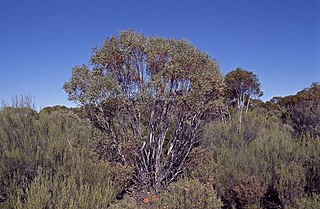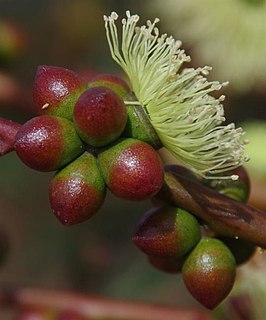
Eucalyptus oleosa, commonly known as the red mallee, glossy-leaved red mallee, acorn mallee, oil mallee or giant mallee, is a tree or mallee that is native to Australia. The leaves were once harvested for the production of cineole based eucalyptus oil. Eucalyptus cneorifolia is now the predominant strain used in production due to a higher oil content in new growth.

Eucalyptus loxophleba, commonly known as York gum, daarwet, goatta, twotta or yandee, is a species of tree or mallee that is endemic to Western Australia. It has rough bark on the trunk, smooth olive to brownish bark above, lance-shaped adult leaves, flowers buds in groups of between seven and eleven, white flowers and conical fruit.

Eucalyptus leptopoda, commonly known as the Tammin mallee, is a species of mallee or rarely a tree, that is endemic to Western Australia. It has smooth mottled grey or brownish bark, sometimes with rough bark near the base, linear to curved adult leaves, flower buds usually in groups of seven and eleven, creamy white flowers and hemispherical to flattened spherical fruit.

Eucalyptus socialis, commonly known as the red mallee, or grey mallee, is a species of mallee that is endemic to inland Australia.

Eucalyptus balladoniensis, commonly known as the Balladonia mallee, is a mallee that is endemic to an area in the south of Western Australia. It has rough bark on the lower half of its stems, smooth brownish bark above, lance-shaped leaves, flower buds in groups of seven, pale yellow flowers and hemispherical to more or less spherical fruit.

Eucalyptus effusa, commonly known as rough-barked gimlet, is a species of mallee or small tree that is endemic to Western Australia. It has thin, rough bark on the base of the trunk, smooth bark above, linear to narrow lance-shaped adult leaves, flower buds arranged in groups of seven, white flowers and cup-shaped to conical fruit.

Eucalyptus kessellii, commonly known as Jerdacuttup mallee, is a species of mallee that is endemic to an area along the south coast of Western Australia. It has very hard, rough bark on the trunk of larger specimens, smooth greyish and brownish bark above, lance-shaped to egg-shaped adult leaves, flower buds in groups of three or seven, creamy white flowers and downturned, conical to cup-shaped fruit.

Eucalyptus mannensis, commonly known as Mann Range mallee, is a species of mallee that is native to Western Australia, South Australian and the Northern Territory. It has rough bark at the base of the trunk, smooth bark above, narrow lance-shaped adult leaves, flower buds in groups of between seven and eleven, creamy white flowers and hemispherical fruit.
Eucalyptus phenax, commonly known as green dumosa mallee or white mallee, is a species of mallee that is endemic to southern Australia. It has smooth bark, lance-shaped adult leaves, flower buds in groups of seven or nine, white flowers and cup-shaped to cylindrical fruit.

Eucalyptus pruinosa, commonly known as silver box, silver leaf box, apple box or smoke tree, is a species of tree or a mallee that is endemic to northern Australia. The Jaminjung peoples know the tree as yarrirra or jarnbiny, the Jaru as wararn and the Wagiman as wararn. It has rough, fibrous to flaky bark on the trunk and branches, a crown composed of juvenile, glaucous, heart-shaped to broadly elliptical leaves arranged in opposite pairs, flower buds arranged in groups of seven on the ends of branches, creamy white to pale yellow flowers and cylindrical to conical fruit.
Eucalyptus quaerenda is a species of mallee that is endemic to the southwest of Western Australia. It is an often rounded mallee with foliage reaching the ground and has smooth bark, linear adult leaves, flower buds in groups of seven, creamy white flowers and shallow, cup-shaped to flattened spherical fruit.

Eucalyptus sargentii, commonly known as Salt River gum, is a species of mallet, mallee or small tree that is endemic to Western Australia. It has rough bark on part or all of the trunk, smooth bark above, linear to narrow lance-shaped leaves, flower buds in groups of seven, whitish to creamy yellow flowers and conical fruit.
Eucalyptus vegrandis, commonly known as the Ongerup mallee, is a species of mallee that is endemic to the south-west of Western Australia. It has smooth bark, linear to lance-shaped adult leaves, flower buds in groups of seven, creamy white flowers and cup-shaped or conical fruit.

Corymbia eremaea, commonly known as mallee bloodwood, hill bloodwood and centre range bloodwood, is a small, mallee-like tree that is endemic to central Australia. Indigenous Australians know the plant as muur-muurpa. It has rough, evenly tessellated bark, lance-shaped leaves, oval to pear-shaped flower buds arranged on a branching peduncle and urn-shaped fruit.

Eucalyptus terebra, commonly known as Balladonia gimlet, is a species of gimlet that is endemic to Western Australia. It has satiny or glossy bark on its fluted trunk, linear to narrow lance-shaped adult leaves, flower buds in groups of seven, yellowish flowers and conical to hemispherical fruit. It is one of the seven species of gimlet.
Eucalyptus alipes is a mallet that is endemic to the south-west of Western Australia. It has smooth grey to light brown or bronze bark, linear to narrow elliptic leaves, oval to spindle-shaped buds with a long, narrow operculum and conical fruits.
Eucalyptus × balanopelex is a mallee that is endemic to a small area of the south-west of Western Australia. It has smooth bark, broadly lance-shaped adult leaves, flower buds in groups of seven, creamy-white flowers and hemispherical fruit. It is thought to be a hybrid between E. kessellii subsp. eugnosta and E. semiglobosa.
Eucalyptus notactites, commonly known as southern limestone mallee, is a species of mallee that is endemic to the southwest of Western Australia. It has smooth, greyish bark, lance-shaped adult leaves, flower buds in groups of between eleven and fifteen, creamy white flowers and hemispherical fruit.

Eucalyptus semiglobosa is a species of mallee or small tree that is endemic to the south coast of Western Australia. It has smooth bark, broadly lance-shaped adult leaves, flower buds in groups of seven, creamy white flowers and ribbed or wrinkled, shortened spherical or hemispherical fruit.

Eucalyptus socialis subsp. eucentrica, commonly known as the inland red mallee, is a subspecies of mallee that is endemic to inland Australia. It usually has rough bark on the base of the trunk, smooth bark above, lance-shaped adult leaves, flower buds in groups of between seven and eleven, pale creamy yellow flowers and barrel-shaped to urn-shaped or spherical fruit.













